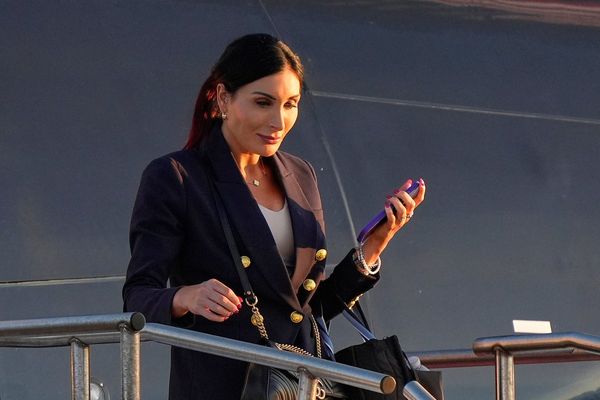
Seldom do works of art – even public art – arrive with such a weight of expectation, or burden of proving themselves, as Lindy Lee’s Ouroboros, the National Gallery of Australia’s newest artwork. No sooner had it been announced, back in 2021, than its price tag – $14m, the highest price the gallery has ever paid for a single work – became the subject of controversy, criticised as extravagant and reckless spending, a “scandalous abuse” of public funds. Lee’s design was disparaged, and likened to “a large sliced bagel, with poppy seeds”.
Three years later, ahead of the work’s official unveiling on Thursday in Kamberri/Canberra, NGA director Nick Mitzevich is philosophical about the initial reactions. “When you announce a commission, and the only thing that you can define upfront is the price, of course that will occupy the initial discussions,” he says. “Now that the work is in place, people can judge and can make assessments [based on] the experience of the work; its materiality and the impact that it has.”
The impact of Ouroboros is undeniable. Installed roadside in front of the NGA, the 13 tonne, 4.2 metre-high structure, made from mirror-finish stainless steel (recycled from scrap metal) and mounted in the middle of a shallow square pool of water, is a showstopper.
There’s something satisfying, on a primal level, about its spiralling, curvilinear form, which evokes the work’s mythic namesake: the snake that eats itself. Instead of scales, the surface is patterned with thousands of circular holes, which disrupt the reflections of water, landscape and sky on the steel. A path across the pool takes you a metre or so inside the structure before ending – hemmed by the water. Inside, in the dappled light filtering through the perforations, it feels cool – even in the heat of a 27C Canberra day.
At night, Ouroboros will be lit from within like a lantern, its 45,000 perforations evoking the vast, starry night skies above.
“The brief was to develop an idea [to mark the gallery’s 40th anniversary] that was a major beacon, a gateway into the National Gallery complex,” says Mitzevich. “We wanted this work to demonstrate the ambitions of Australian art.”
If there’s one disappointment, on first viewing of Ouroboros, it’s that you can’t walk in further; per the gallery’s website, only two people can fit at a time. Lee, who I meet mid-morning inside the work, confesses she’s also disappointed about this – before stepping out of her shoes, off the platform and into the water, striding towards the tail of the snake. “You didn’t see me do this,” she says, with a cheeky grin. This project has left her wanting to do an even bigger walk-in work, she says.
Ouroboros is the latest in a decade-long series of large-scale reflective, perforated sculptures titled The Life of Stars, in which Lee has expressed her childhood fascination with the starry skies as well as key tenets of her Buddhist philosophy, including “Indra’s net”: the concept of an infinite cosmos in which everything is interconnected. Public artworks from the series can be found in Tarndanya/Adelaide (outside the Art Gallery of South Australia), Warrane/Sydney (outside the Museum of Contemporary Art), Meanjin/Brisbane (at the Queen’s Wharf precinct), Hong Kong and Shanghai, among many other locations in China.
It was the Life of Stars that spurred NGA’s choice of Lee, who turned 70 this year, for its 40th anniversary commission. “We saw that Lindy’s practice kept evolving, becoming more and more ambitious. She’d done a number of key major public works internationally, and so we were heartened by that, and noticed that she didn’t have any major site-specific works in Australia – so we thought that that was something that we could work with her on,” says Mitzevich.
Invited to dream big, Lee landed on the ouroboros: the symbol of a dragon or snake eating itself, representing infinity and the eternal cycle of destruction and re-creation. She was pleased to discover, from her conversations with Aunty Jude Barlow, Ngunnawal elder-in-residence at NGA, that the symbol had relevance in many Aboriginal cultures too, evoking the rainbow serpent creation spirit.
Lee says the perforations on the work, and the shadows they create, symbolise the fusion of “matter and spirit”; the tangible and intangible. In this way, she hopes it evokes “the 10,000 million invisible things that have had to [happen] to bring one person [or moment] into existence.”
Executing her vision took more than three years and more than 200 engineers, technicians and fabricators from UAP, the Meanjin/Brisbane-based design studio, workshop and foundry that has collaborated with Lee on many of her large-scale sculptures over the last decade.
Ouroborus presented a new challenge for UAP: making a perfectly circular structure with no internal frame – something that had not been done before in Australia. In the end they turned to an engineer who works with British sculptor Anish Kapoor for his expertise.
The sculpture’s unusual structure meant that each of the perforations had to be engineer-tested to make sure they wouldn’t compromise its overall integrity. It also necessitated a painstaking approach in which 300 panels – each unique – were joined with about 2 kilometres of solder. “And every single one of those circles is hand-cut,” adds Lee.
When you consider the considerable time and labour, the $14m price tag makes a bit more sense. That amount also includes Lee’s fee (a “single digit” percentage of the total, which covered her own salary and travel, and that of her studio assistants), as well as transport for the work, which travelled nearly 2,000 km down the centre of Australia on a flatbed truck, driven with great care given the unwieldy size of the precious cargo, and with a convoy to lift power lines and remove other obstacles where necessary.
Even so, sceptics might well ask whether spending so much on a single project is wise when the NGA remains so cash-strapped that it has been unable to undertake urgent repair works to its building – a point vividly illustrated during my visit by a bucket in the entrance area, placed under a roof leak.
Mitzevich says that the money for Ouroboros came entirely from the gallery’s Collection Development Fund, an annual allocation provided by the federal government exclusively for artworks and acquisitions. “We couldn’t swap out the money for art to fix the roof, for example,” he says.
The budget for Ouroboros, he says, “was about defining something of scale and ambition, but it wasn’t an open cheque. We rigorously explored the idea first, and then we worked with a quantity surveyor to make sure that the cost was reasonable and justifiable.” He also points out that the work “is available 24/7, and it’s free”.
For those who can’t get to the nation’s capital, a small version of the sculpture, titled Abundance and made from $10m in gold (supplied by the NGA’s new corporate partner, Pallion, a precious metals group) will tour the country in 2025. Abundance is on permanent loan to NGA from the Pallion Arts Program, and currently on display as part of a mini-exhibition of Lee’s work at the gallery.
In the meantime, Lee hopes visitors lean into what she describes as an “intimate experience” with her behemoth new work. “[Ouroboros] is an invitation to be still, to let go of your habitual thinking and just experience being intrinsic to this vastness.”







